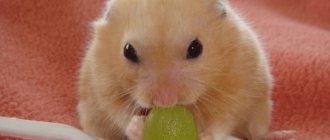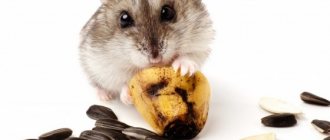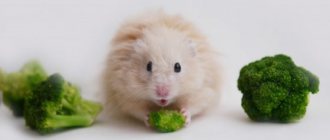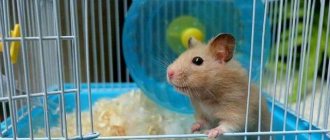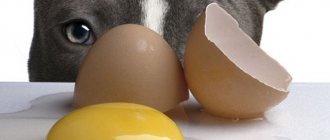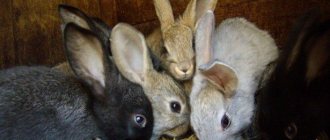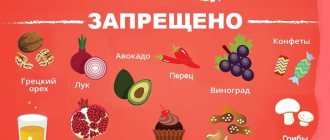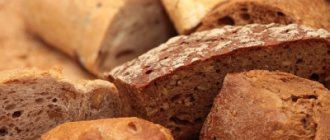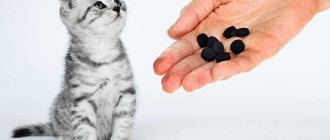Wild field hamsters in their natural habitat are omnivores; they feed on almost any plant food that comes their way. Domestic hamsters living with people do not have this opportunity. Their diet completely depends on the owner, who often offers them what he eats himself, for example, all kinds of fruits and berries. The vitamins and various microelements contained in these fruits are undoubtedly beneficial. But is it possible to pamper a hamster with them, and won’t this cause irreparable harm?
Can hamsters eat fruit?
In addition to a large supply of vitamins, fruits contain fiber, which plays an extremely important role in digestion. However, their high sugar content makes them potentially dangerous for diabetic rodents. Not all fruits are healthy and recommended for pet hamsters; some exotic fruits are strictly contraindicated.
Banana and banana chips
Bananas can be introduced into the diet of hamsters, but rather carefully, since they are very high in calories and contain a lot of sugar. This delicacy can be given no more than 1-2 times a week, and a single serving should not exceed 5-6 g (a quarter of a teaspoon). Obviously overripe and especially rotten fruits are not suitable. It is better to give preference to unripe and even slightly greenish fruits (they contain less sugar).
Overeating bananas is dangerous not only for the development of diabetes, but also for the possibility of obesity. The heart suffers from increased stress due to weight gain, and individual allergic reactions to bananas are not excluded. Sticky fruit pieces can clog your hamster's airways, sticking in the throat and other cavities of the digestive tract, causing breathing problems, choking and even death. Dry banana chips are less dangerous in this regard, but they are even sweeter and higher in calories, so you can’t give them too much. It is recommended to prepare chips yourself, since purchased products contain many different additives that are far from safe for small rodents.
It is better to avoid feeding banana skins to hamsters altogether, since the fruit is treated with chemical compounds for better preservation during transportation. These substances are extremely dangerous for all animals and can cause severe poisoning.
However, one cannot fail to note the benefits of banana; it contains the following necessary substances:
- iron - maintains hemoglobin at the proper level, restoring strength and relieving fatigue;
- potassium and magnesium - necessary for the normal functioning of the cardiovascular system, as well as the musculoskeletal system;
- phosphorus - strengthens bone and tooth tissue.
Apple and pear
Apples in moderation (no more than once a day, 10-15 g) are very beneficial for hamsters. This low-calorie fruit contains no cholesterol and has a positive effect on the body:
- strengthens the immune system, as it contains vitamins (groups B, C);
- supports the normal functioning of the cardiovascular system thanks to potassium;
- prevents cancer by being a source of antioxidants;
- improves blood composition, because it is rich in microelements (iron, phosphorus, copper, etc.).
Hamsters should not be given too many apples, as this can cause problems with the digestive system (increased gas production) and increase sugar levels. Dried pieces can be safely added to prepared food. Fresh fruit must first be washed and removed from skin and seeds. If it is bought in a store, it is better to soak it in water for 2-3 hours to remove harmful substances. Apples grown on your own plot (without the use of chemicals or pesticides) can be given with the peel. It is preferable to choose varieties with a sweet and sour taste.
Hamsters react to pears in different ways: some individuals eat it with pleasure without any negative consequences, while others feel bad. Therefore, the decision to introduce this product into the diet is made purely individually. Eating pear has the following effects:
- has a diuretic effect;
- prevents the formation of salt deposits;
- strengthens vascular walls;
- has an anti-inflammatory effect;
- helps with constipation.
The negative impact of a hamster eating a fresh fruit is irritation of the gastric mucosa, increased formation of gases, as well as possible allergic manifestations. Peel the fruit, remove the seeds, cut into small pieces of 10-12 g and give one twice a week. You can feed dried pear pieces without fear for the hamster’s health, but not more than once every couple of weeks (1-2 pieces).
Watermelon and melon
Melon crops, such as watermelon and melon, are absolutely contraindicated for hamsters. As a result of eating fruits containing a huge amount of liquid, they are guaranteed severe diarrhea. Tender fruit pulp, even if left in the feeder for a short time, deteriorates quite quickly, in which case poisoning is inevitable.
The huge amount of fertilizers and dangerous pesticides used on melons and contained in watermelons and melons is deadly for small rodents.
Apricot, peach and nectarine
Stone fruit crops (plum, cherry plum and apricot) grown in local climatic conditions can be grown for hamsters, but you just need to remove the seeds from them. Spoiled or stale fruits should not be given, as the juicy pulp quickly rots and becomes covered with dangerous fungi and bacteria. The entry of pathogens into the body is fraught with poisoning and intestinal upset.
Sweeter peach and nectarine are allowed in very small quantities (a piece of 3-4 g) and no more than 2-3 times a month strictly as an exclusive delicacy. Sugary fruits eaten in excess by a hamster can lead to weight gain and diabetes. Before consumption, all fruits should be thoroughly washed; dirty surfaces contain not only pathogens, but also worm eggs.
What do they give to weakened, elderly individuals?
As an animal ages, its teeth become weak and food is difficult to chew. Special, pureed, ground food is required. Chopped nuts, crushed peas, rye bread crumbs, rolled oats, baby food, porridge, and unseasoned purees are suitable. It is impossible to refuse the grain component - cereals contribute to the activation and normal functioning of the digestive organs. You can offer a ground fruit mixture, add medicines and vitamins to the feeder with the prepared product. Human drugs cannot be given - their dosage and composition are destructive.
The pet's menu needs to be diversified. You cannot feed the same foods over and over again. Mono-diets are unacceptable. It’s good if dry, juicy, protein foods are present in the diet every day.
It is useful to give chamomile decoction to water for sick and elderly pets. If the animal is weak and refuses to eat, the food is ground to a paste-like consistency, fed and watered warm from a syringe without a needle.
Feeding a small mammal at home is entirely up to you. When keeping an apartment, a pet needs a reasonably designed menu that includes vital components. Try to create a menu for your baby that includes a lot of fresh, healthy vegetables.
Treat your pet correctly, at the same time, without relying on his choice. The baby will eat poisonous plants placed in the feeder without a doubt; he is indiscriminate and omnivorous. He will like high-calorie foods. The pet will eat sweets with pleasure. Remember: in nature, rodents do not receive such nutrition, which means there is no benefit in it.
The bowl is selected in accordance with the nutritional needs of the animal; it should be small, not allowing overfeeding, made of ceramic. This will prevent you from chewing it or choking on parts of the dishes.
There is debate about the necessity of various products. We are talking, for example, about beets and radishes. If you have doubts about the usefulness, potential risk, or fears for the existence of your pet, it is better to refuse and not conduct experiments. There are many more necessary, useful products.
If the animal was bought for children, adults should immediately explain to the kids the rules of keeping and proper feeding of the pet. Play with the animal, maintain constant contact. Then the life of your tiny funny friend will be joyful, happy, long.
Citrus fruits (oranges, tangerines and lemons)
Absolutely any citrus fruits (tangerine, lemon, lime, orange, grapefruit, pomelo) cannot be given to hamsters. These fruits are harmful for the following reasons:
- a high content of vitamin C can provoke hypervitaminosis;
- acids from citrus fruits corrode tooth enamel and irritate the mucous membranes of the esophagus, stomach and intestines;
- cause allergies.
It must be remembered that both the pulp of citrus fruits and their peel are harmful. Even intensive washing is not able to wash away the chemicals used for preservation from imported fruits.
How does the metabolism of domestic rodents work?
Small animals have a high metabolic rate, so they need to constantly chew something. During the day, an adult dwarf eats up to 70% of its own weight.
For this reason, they often suffer from diseases such as diabetes and obesity, especially given their sedentary lifestyle compared to their wild relatives.
An important point is that you cannot feed your hamster all the time or add food just for fun, just because he often stands on his hind legs and shows a desire to eat something.
Fluffy will eat everything, but it is very harmful. Sitting in a confined space and constantly eating high-calorie foods, the hamster will quickly gain excess weight and a bunch of health problems.
Animals should definitely be allowed out for walks, played with, and a running wheel should be placed in the cage so that the kids do not gain excess weight. Fluffies should be fed in the morning and evening.
Dried fruits
Hamsters can occasionally be pampered with dried fruits (dried apricots, raisins, fruit chips). But you can’t get carried away with them, since the sugar content in them is high. In addition to raisins, Syrian hamsters are given a little dried apricots. For miniature jungarians, who are more prone to obesity, it is better to offer less sweet dried pieces of apples or bananas. But prunes are contraindicated for hamsters; it is better to avoid them completely.
Banana chips are already included in some ready-made feed mixtures.
White bread
Wheat bread, loaf, bagel, bun - the names of the most popular flour products made from wheat. Wheat is a very healthy grain for a hamster; it is included in grain feed. But after milling and processing, the composition of wheat changes greatly. Flour no longer contains much important fiber and microelements, but carbohydrates and sugars remain, which are so harmful to animals. To make the bread so snow-white, food bleach is added, and for fluffiness, leavening agents, stabilizers and yeast are added.
This product is not at all beneficial for the digestion of a small animal. Carbohydrates cause obesity, diseases of the thyroid and digestive systems, and put a lot of stress on the hamster’s kidneys.
If a hamster eats white bread containing yeast, the following consequences are possible:
- bloating, flatulence;
- loose stools;
- loss of appetite.
With prolonged use of products made from white flour, digestive problems begin, the pet's weight increases, and mobility decreases.
What berries can you give?
Juicy seasonal berries should undoubtedly be present in a hamster's diet, because they are a rich source of a wide range of vitamins and minerals. Eating them helps keep the immune system in order; you are allowed to treat:
- wild forest rowan;
- blackberries;
- strawberries;
- blueberries;
- cranberries;
- strawberries;
- white and red currants.
In very limited quantities, the hamster is occasionally given the following berries:
- lingonberries;
- blueberries;
- chokeberry;
- ripe unsweetened grapes (seedless);
- pitted cherries and cherries;
- raspberries;
- gooseberry;
- black currants.
Conclusion
So can hamsters eat bread? White fragrant loaf, even if it looks appetizing to you, is not recommended to be given to a hamster. The same goes for aromatic black bread and ready-made crackers. Homemade, hand-cooked crackers will help diversify your rodent's diet.
Remember that proper care and a healthy diet can extend your pet's life up to three years, while feeding non-recommended foods, including sweet rolls, can shorten your hamster's life to up to a year. Be careful about those you tamed!
Did you like the article? Share with friends: [supsystic-social-sharing id=”1"]
- Related Posts
- Can hamsters eat kiwi?
- Can hamsters have melon?
- Can hamsters have a pear?
« Previous entry
